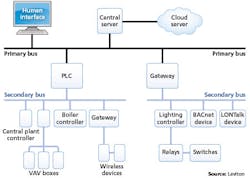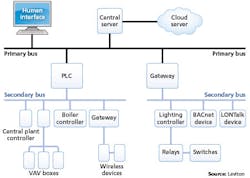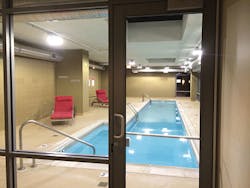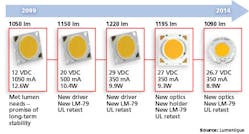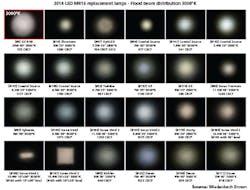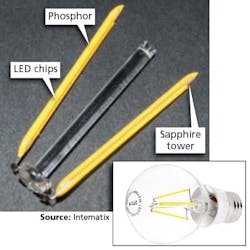Conference presenters at The LED Show 2014 noted trends toward adaptive lighting and integrated networks, the introduction of ever-more-compact lighting solutions, and the proliferation of LED lighting even beyond existing lighting applications, reports LAURA PETERS.
The LED Show this past September in Los Angeles featured speakers from diverse backgrounds, from lighting designers and installation specialists to LED manufacturers. The speakers noted trends in lighting design and especially in networks and control implementations, while recognizing hurdles in lighting design that have yet to be overcome. Still, the prevalent theme focused on the fact that solid-state lighting (SSL) will dominate general illumination going forward - and that both product developers and lighting specifiers/designers must learn to optimize the use of the upstart sources.
LED proliferation is evident
Several presenters demonstrated just how many places LED lighting is found today. Louis Brill, a consultant with Illuminations, noted that while many buildings now use an LED lighting "skin" to decorate the architecture beneath it, the latest application involves using the façade or parts of the façade for video presentations, which he calls "mediatecture." Mediatecture is used to provide art, cultural information, entertainment, and social commentary within the public space. Examples include the NASDAQ façade in Times Square, NY (which has shown operas) and The Comcast Experience visual wall in Philadephia, PA (which conveys community information, nature scenes, and sports highlights). According to Brill, these dynamic light shows can not only inform and entertain passers-by but also preserve the visual identity of the local community. "I believe digital art will do to public space what the phone did to private space," said Brill.
With an emphasis on everyday white lighting, Eric Haugaard, director of product technology at Cree Lighting, indicated that the era of LED lighting proliferation has begun in full force. He said that despite SSL's low market penetration of only 1.4%, LED adoption is moving very quickly, especially in the areas of street lighting, warehouse lighting, and locations where maintenance severely interrupts operations or is very costly, such as in hospitals and outdoor stadiums. Haugaard pointed out that LEDs now offer superior illumination to many legacy sources, and when combined with economic viability, SSL becomes a "no-brainer."
Haugaard compared smart luminaires to smartphones, indicating that voice is only one function of smartphones today and light will soon be only one of several functions performed by light fixtures. In addition, lighting systems are typically autonomous but will eventually be interfaced with other networked systems such as security and energy management systems for greater energy efficiency and operational efficiency.
Smart lighting, networks, and controls
Several presenters pointed out the statistic that lighting accounts for 38% of a building's electricity use. In fact, a recent article in Illumination in Focus stated that lighting controls have the potential to eliminate 60% or more of wasted lighting energy in buildings (http://bit.ly/1wtGUTw). The article explored how lighting control requirements are driving a reduction in building energy use.
At The LED Show, Greg Galluccio, director of LED business development at Leviton, highlighted the trend toward lighting fixtures that control themselves. Once lights are added to an Ethernet connection they become IP-addressable, which is required for energy monitoring by utilities. Galluccio suggested some benefits of automated lighting beyond dimming, occupancy sensing, and daylight sensing and control. These benefits include the ability to show emergency routes indoors and outdoors, illuminate crime scenes outdoors, and provide warnings, such as a red color on a doorbell.
Galluccio outlined some of the challenges associated with creating fully automated building systems - integrating lighting control with security systems, HVAC controls, audio/visual systems and conferencing, and energy management/load control systems (Fig. 1). He said that because each of these systems was developed at different times and each uses its own sensing and control devices, integration becomes difficult. Two-way communication is needed between devices and between each device and its controller. There is also a need to prioritize certain control commands over others and to enable system overrides in case of emergency. Galluccio said the wide range of wireless protocols in use also presents challenges. However, each system has the potential to be run more effectively and maximize energy savings in the full building automation scenario.
Dimming issues persist
Moving to what is often the result of controls, good dimming remains a problem in the SSL sector. Indeed, smooth dimming was the subject of the presentation by Richard Zulch of Zulch Industries. He focused on flicker during dimming, which is most noticeable over a large viewing area such as in a large room.
Using DMX (digital multiplex) control or in-line dimming, Zulch stated that different approaches have been used to eliminate flicker including increasing pulse-width modulation (PWM) resolution and utilizing dimming curves. We had a feature article that explained the use of dimming curves in late 2013 (http://bit.ly/1rfY6pW).
Zulch stated that flicker still occurs with approaches such as improved PWM drive. He explained that smooth dimming results when large changes in light intensity are made during the beginning of a ramp and small intensity changes are made toward the end of ramps (Fig. 2). In this way, small changes in intensity are being made during the periods when the eye is most sensitive to those changes. Zulch suggested that these minor hardware and software modifications could be incorporated into the luminaire or driver itself to achieve smooth dimming rather than using a DMX controller or in-line dimmer.
Multicolor lighting and color tuning
In the area of color lighting, Eman Zadeh, brand director of Coloronix talked about the various control options. An inexpensive option using infrared (IR) or RF control is suitable, for instance, for a patient to control lighting in his/her room in a hospital. However, IR/RF control is limited in that all fixtures show the same colors at the same time. For greater control flexibility, Zadeh recommended DMX, which is the mostly widely available method and affords different control options for small- to medium-sized projects. DMX accommodates up to 150 lighting fixtures. For large-scale projects, he recommends IP/Ethernet methods that manage multiple DMX universes.
Colored lighting can use LED combinations of RGB, RGBA, RGBW, or RGBAW (A = amber, W = white). The addition of phosphor-converted white LEDs allows higher overall lumen output. To limit rainbow or shadow effects, Zadeh suggested choosing fixtures that mix the color internally. Some of the areas adopting colored lighting today include hospitals and other healthcare settings, corporate offices (indoor and façade lighting), nightclubs and restaurants, as well as residences.
Jeffery Saake, executive vice president of Lumenetix, spoke of the rising popularity of color tuning. "We expect color tuning to become as prevalent as dimming." He views color tuning as part of the lighting industry's third wave in SSL, which focuses on functionality and connectivity (the first wave involved energy efficiency and lifetime; the second wave involved controls). Saake sought to dispel myths that color tuning leads to low efficacy and that it is a niche technology, difficult to control, and expensive. He said color-tunable sources enable the color temperature, or range of color temperatures, to be set at the time of installation or any time thereafter to optimize visual appeal, wellness, or personal preference. In other words, designers would not have to select a specific color temperature at the time of design because objects in a space are subject to change.
Because color tuning uses multicolored LEDs, managing the systems requires real-time digital control and active, closed-loop feedback. For instance, a five-channel system is needed to control RGBAW LEDs and their thermal sensitivity requires on-board temperature monitoring to maintain color specifications. In these systems, LED lifetime varies based on usage so monitoring and feedback of light output is needed, again, to correct the color point. Saake concluded that in color tuning, having the proper hardware and software architecture is key to delivering consistent light quality and acceptable efficacy over the full tuning range. We published a recent Illumination in Focus feature article in which lighting and LED manufacturers discussed SSL issues including color tuning (http://bit.ly/ZGIdBn).
Pivotal role of lighting designers
Of course, the design/specification community must learn to effectively use the expanding capabilities of SSL systems. In his presentation "How design can save lighting," Ted Konnerth, CEO of Egret Consulting, stated that lighting designers need to take their rightful place on the national stage of SSL as the "guardians of the bastions of quality lighting." He indicated that there has been an influx of new companies into SSL, including 600 new lighting manufacturers since 2006. With many new entrants and a predominantly technical approach to lighting, Konnerth says designers need to play an active role in the development of standards and code requirements to ensure that quality lighting is maintained. Beyond important lighting metrics such as efficacy, lumen output, luminous distribution, and the like, designers are needed to define the essential attributes of lighting as it becomes integrated with building automation systems, energy management systems, and security systems.
Derry Berrigan, chief innovation officer at Light Think Studios and chair of Light Think University, is an advocate of people-inspired energy-efficient lighting design. In her presentation, Berrigan emphasized the need to consider the experiential context when installing new lighting and illustrated the consequences when context is not considered in a project. She showed an indoor pool area in a condominium that had undergone a 1:1 lighting retrofit of metal-halide fixtures for LED parking garage fixtures (Fig. 3).
The room has two skylights, so indoor lighting is only needed four hours per day. The retrofit, performed by the residence's building manager, cost $33,000 and resulted in 102 fc of illumination in an area that required perhaps 10-20 fc. In addition to being overlit, glare and harsh direct light from the fixtures proved unacceptable to swimmers. To solve the problem, 15 of the 18 fixtures were turned off permanently and custom diffusers were made to dampen the light from the three illuminated fixtures.
Also focused on indoor spaces, Paul Ford of The Lighting Quotient outlined methods for choosing light fixtures for architectural wall and ceiling lighting. Ceiling lighting, which can make rooms appear larger and less cluttered, is typically performed indirectly. Ford began with the Lighting Facts list of wall-washing products and indicated that people might choose a product based primarily on lumen output, or lumen output and efficiency. However, he showed how two products delivered very different percentages of light to the wall itself. "It's important to look for an asymmetric photometric distribution with wall washers, as well as high delivered lumens to the wall," he noted. The same rules hold when selecting cove lighting, where delivered lumens to the space of interest is key. Finally, he indicated a trend in office lighting toward fixtures that are integrated with furniture. As office layouts change, the light moves with the employee.
LEDs: Packages to LED-scale fixtures
The discussion also included a look at the challenges of working with packaged LEDs at the luminaire level including remarks from Kevin Willmorth, the founder of Lumenique, LLC and Tasca. He stated that several trends including an increasing number of standards, multiple control options, and a preponderance of LED options contribute to a long design-in period for fixture manufacturers. In particular, he pointed out the mismatch between LED design cycles of 2-4 months and lighting design cycles of 18-24 months, which leads to costly and repeated LED re-evaluations during fixture design (Fig. 4). Willmorth stated that although there is a performance gain associated with designing in ever-higher performing LEDs (83 lm/W to 122 lm/W in the case shown), the burden of retesting needs to be addressed.
Lara Cordell, LC, LEED AP at Wiedenbach Brown, a provider of smart lighting and electrical services, also highlighted the problem of rapidly changing LED technology for fixture manufacturers. She stated that re-specification of the LED or module is often required at the time of lighting product procurement, a change that significantly impacts project budgets and delivery timelines.
Cordell also discussed changes in the way lighting designers view LED lighting. "In 2010, lighting designers took a 'guilty until proven innocent' view because there were many untested, expensive lighting products, but in 2014 the view has changed to 'innocent until proven guilty' due to access to many high-quality lighting products at accessible price points." Cordell noted that it has become easier to obtain LEDs with CRI exceeding 90 and high R9 values, but the industry is still seeking a better way to describe color than the CRI metric.
Beyond this issue, Cordell stated that LEDs have introduced variability in unexpected places. For instance, there is great variability of beam intensity among commercial LED spotlights, which makes specifying the products difficult without seeing samples of each in the application. While legacy sources specify a center beam candle power (CBCP), beam intensity is 50% of CBCP at the beam angle edge and 10% of CBCP at the field angle edge, whereas LED spotlights deliver a variety of intensity distributions (Fig. 5). Cordell proposed that product specification sheets include a standard method to describe the beam profile. She is part of an industry group, the LED Group - made up of lighting designers, researchers, lighting manufacturers and distributors, and industry media - that plans to address such specific SSL issues as beam profile variability.
Summary of SSL market transformation programs. | |||
Energy Star | DLC | LED Lighting Facts | |
Technologies | CFL and LED | Only LED | Only LED |
Focus area | Residential | Commercial | Both |
Product types | Lamps and residential luminaires | Luminaires | Both |
Minimum requirements | Yes | Yes | No |
Voluntary | Yes | Yes | Yes |
Family grouping | Yes | Yes | Yes |
Primary function | Certification program | Qualification program | Performance verification |
Funding | EPA | Utilities/application fees/grants | DOE |
Verification | Yes | Yes | Yes |
Julian Carey, senior director of marketing for phosphors at Intematix, spoke of a movement toward delivering lamps and luminaires with fewer, better components. Such a change can result in improved performance and lower cost. His example was of clear replacement bulbs where the LEDs are integrated onto a filament-shaped substrate (Fig. 6). These LED bulbs are popular because they mimic incandescent bulbs and are attractive for bare bulb applications. The design offers the benefit of removing heat from the LED via the inert gas inside the bulb, so no exterior heat sink is required. Carey, who calls the design a "chip-scale fixture," said, "This is a more efficient, compact approach where the LEDs and surrounding materials are the fixture."
Another integrated scheme involves the combination of light diffusers with phosphor materials to make a single structure that provides diffuse, uniform light with more efficient light extraction from the LEDs. These lamps with integrated diffusers will soon appear in linear fixtures for offices and commercial spaces.
The evolving role of standards
Standards and market transformation programs were also addressed at The LED Show. Marci Sanders of the US Department of Energy (DOE) LED Lighting Facts program, Taylor Jantz-Sell of the US Environmental Protection Agency (EPA's) Energy Star program, and Irina Rasputnis of the DesignLights Consortium (DLC) provided program updates and demonstrated ways in which the programs work together. For instance, the data required for Lighting Facts satisfies 75% of the data requirements for the DLC and Energy Star. The table outlines the programs, some similarities, and differences.
The Lighting Facts database now lists 20,000 lamps and luminaires from more than 170 manufacturers. Energy Star, which sets minimum performance and energy-efficiency guidelines for residential lighting products, now works with more than 2600 retailers and 900 utilities in the US. In 2014, the average utility rebate per lamp is $9.95. Rebates on CFL products will be phased out through 2018, as the number of utility rebates continues to increase for LED lamps.
The DLC Qualified Products List (QPL) promotes commercial lighting products to member utilities in the United States and provinces in Canada. Rasputnis suggested that companies ensure their products will pass qualification testing prior to submission, which costs $500 per individual product and $25 for each subsequent product in the same family. To date, over 60,000 products can claim DLC qualification and use the DLC logo in product promotions. Due to industry suggestions, Rasputnis noted that the DLC is in the process of developing a product challenge policy.
Ruth Taylor, program manager at the DOE and Pacific Northwest National Laboratory (PNNL) announced the winners of the 2014 Indoor NGL Design Competition at The LED Show 2014, recognizing lamps and luminaires that exhibit excellence in performance and design. See further coverage of that program on p. 29.
Chad Stalker, regional marketing manager of Philips Lumileds at the time of his presentation but now an Acuity executive, further discussed the value of standards activities. He said Energy Star certification and DLC qualification, beyond the obvious benefits of product rebates, build confidence in the purchase of lighting products because people recognize the value behind certification and qualification testing. Stalker said among all the steps in a product's lifecycle - LED manufacturing and testing, lamp manufacturing and testing, lamp certification or qualification, and system installation - oftentimes the greatest hurdles exist during installation. Furthermore, he said that people do not always realize how high the cost of non-compliance can reach, citing one case where a manufacturer's liability amounted to $21 million because it had made false claims regarding the lifetime of its lamps.
Economics of SSL
Of course, LED lighting remains expensive and part of the issue for designers/specifiers is justifying the expense. Don McDougall, principal with Solid State Capital Services (SSCS), outlined a strategy to make SSL more attractive by selling directly to the top executives at a company. He suggested approaching CEOs and CFOs, who consider all costs that affect the bottom line of the business, rather than facility managers, who often focus mainly on their budgets.
McDougall suggested speaking to CEOs and CFOs in a language they can relate to, and presenting them with a 10-year cash-flow model to demonstrate the full savings of a lighting upgrade. The model should include rebates, HVAC and energy savings estimates, tax benefits, and maintenance savings. With regard to tax benefits, for instance, abandonment of assets and depreciation of assets provide savings with even small lighting upgrades. Lighting can qualify as a short-lived asset and can therefore be depreciated over 5 or 15 years according to the United States tax code. Also, McDougall noted that LED lighting upgrades improve property value (http://bit.ly/1wah8F6).
LAURA PETERS is a contributing editor with LEDs Magazine.
